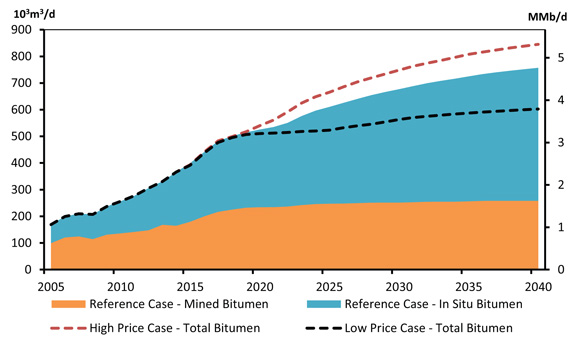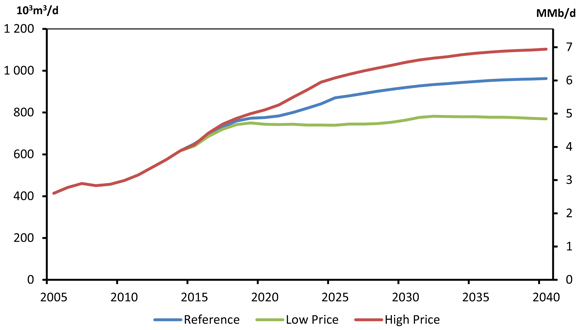ARCHIVED – Fact Sheet - Canada’s Energy Future 2016: Energy Supply and Demand Projections to 2040 - Crude Oil and Bitumen Production Highlights
This page has been archived on the Web
Information identified as archived is provided for reference, research or recordkeeping purposes. It is not subject to the Government of Canada Web Standards and has not been altered or updated since it was archived. Please contact us to request a format other than those available.
Canada’s Energy Future 2016: Energy Supply and Demand Projections to 2040 provides projections of Canadian energy supply and demand to the year 2040. Canada’s Energy Future 2016 includes a baseline projection, the Reference Case, based on the current macroeconomic outlook, energy price projections, and government policies and programs that were law or near-law at the time the report was prepared. EF 2016 includes additional projections that vary assumptions on energy prices, energy markets, and infrastructure. For detailed information, please see Chapter 5 of the full report.
Crude oil production increases over the projection period, but dependent on higher prices
- By 2040, Canadian crude oil production in the Reference Case reaches 963 10³m³/d (6.1 MMb/d), 56 per cent higher than 2014 levels. By the end of the projection period, oil sands production accounts for 79 per cent of total production, compared to 59 per cent in 2014.
- Oil sands production continues to grow over the projection period, reaching 757 10³m³/d (4.8 MMb/d) in 2040. The industry continues to develop in situ projects and focuses less on mining and upgrading projects. The economics of mining and upgrading operations are relatively less attractive compared to in situ over the projection period.
Oil Sands Production, Reference Case

- The effect of recent low crude oil prices on oil sands production is limited in the near-term projections. Oil sands producers are unlikely to lower production from currently producing projects or delay projects that are nearly complete. Production growth in the next five years keeps pace with recent years. Although production continues to grow post 2020, it does so at a slower pace because of operators’ current decisions to defer or cancel projects.
- EF 2016 includes a Low Price Case in which oil reaches $55 per barrel in 2020 and $80 per barrel in 2040. The impact of low prices on Canadian oil production is relatively muted over the next three to four years. The momentum created by recently completed and under construction oil sands projects means production in the Low Price Case is similar to that of our Reference Case.
- However, after 2020, oil production is essentially flat at about 4.8 million barrels per day for the next two decades. Prices that are lower for longer mean investment will not be significant enough to grow production beyond what will be reached in the next few years.
- In the High Price Case production reaches 1 103 10³m³/d (6.9 MMb/d), 15 per cent higher than the Reference Case
Total Canadian Oil Production, Reference, High and Low Price Cases

- Date modified:
